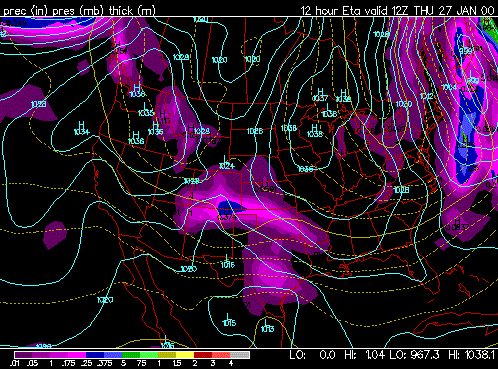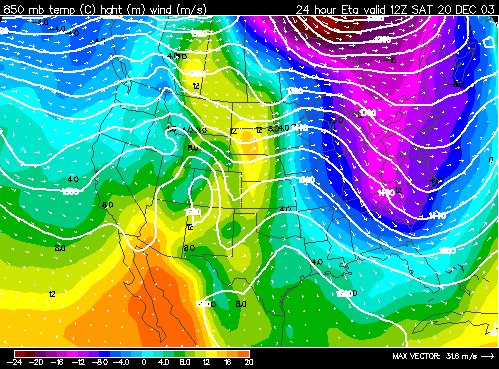BY: UNITED KINGDOM WEATHER RESOURCES
"Thickness" is a measure of how warm or cold a layer of the atmosphere is, usually a layer in the lowest 5 km (17,000 feet) of the troposphere; high values mean warm air, and low values mean cold air.
It would be perfectly feasible to define the average temperature of a layer in the atmosphere by calculating its mean value in degrees C (or Kelvin) between two vertical points, but an easier, practical way to measure this same mean temperature between two levels can be gained by subtracting the lower height value of the appropriate isobaric surface from the upper. Thus one measure of thickness commonly quoted is:
height (500 hPa surface) - height (1000 hPa surface) [ for those of you, like me, too old to catch up with all the changes the world brings, millibars = hPa, so 500 hPa is exactly the same as 500 mb.
In practical meteorology, the most common layers wherein thickness values are analysed and forecast are: 500-1000 hPa; 850-1000 hPa; 700-1000 hPa; 700-850 hPa and 500-700 hPa. By subtracting the lower (height) value from the upper value, a positive number is always gained. The 500-1000 hPa value is used to define 'bulk' airmass mean temperature, and can be seen on several products available on the Web. The other 'partial' thicknesses are used for special purposes, for example, the 850-1000 hPa thickness is used for snow probability and maximum day temperature forecasting, as it more accurately defines the mean temperature of the lowest 1500 m (5000 ft) or so of the atmosphere.
Advection is simply the meteorologists word for movement of air in bulk. When we talk about warm advection, we mean that warm air replaces colder air, and vice-versa. These 'bulk' movements of air of differing temperatures can be seen very well on thickness charts, and differential advection, important in studies of stabilization / de-stabilization, can also be inferred by considering advection of partial thicknesses.
If you pull up thickness charts from the web, it it useful to highlight the isopleths of thickness, and work out, from either the mslp pattern, or the 500 hPa pattern, whether cold or warm advection is taking place. It should be possible with practice to find warm and cold fronts (tight thickness pattern), and areas where the thermal gradient (spacing of thickness lines) is changing - note particularly areas where developments tend to decrease spacing of thickness lines -->> increased potential for atmospheric development.
Can the 500-1000 hPa patterns be used to infer the snow risk? Well, yes they can, but because the layer is so deep -- some 5 km, or 17,000 ft of the lower atmosphere, its not a good indicator.
Rain and snow are equally likely when the 500-1000 hPa thickness is about 5225 gpm (or 522 dam). Rain is rare when the 500-1000 hPa thickness is less than 5190 gpm. Snow is extremely rare when the 500-1000 hPa thickness is greater than 5395 gpm.
[ Q ] Thickness? ....thickness of what?
[ A ] From time to time in meteorology newsgroups, the word 'thickness' is used, particularly when talking about snow probability, or the prospect of warmer, or colder weather generally. If you simply want to remember that 'Thickness' is a measure of how warm or cold a layer of the atmosphere is, usually a layer in the lowest 5 km, or 17,000 ft of the troposphere, and that high values mean warm air, and low values mean cold air, then you can ignore the rest of this FAQ. If you wish to know a little more, read on!
[ Q ] What is 'Thickness' and how is it measured?
[ A ] Although it would be perfectly feasible to define the average temperature of a layer in the atmosphere by quoting/calculating its mean value in degrees C (or Kelvin) between two vertical points, from the early days of upper air meteorology, it was realized that from the hydrostatic equation, an easy to calculate measure of this same mean temperature between two levels could be gained by subtracting the lower height value of the appropriate isobaric surface from the upper.
The hydrostatic equation, in its simplified form, is -dp/dz = pg/RT ...... Eq(a)
here:
dp being the pressure difference across two defined levels
dz the height difference between those two levels
g the gravitational constant
R specific gas constant for dry air
T average temperature in layer (strictly average virtual temp.)
Eq (a) states that the change of pressure with height (above a point where the total pressure of the column is p), is governed by the mean temperature over the vertical distance involved. Thus in cold air/low T values, -dp/dz is larger than in warm air/high T. ... or putting it another way, lets start out at 1000 hPa and ascend vertically; in cold air, you would reach the level of 500 hPa sooner (greater rate of change of p) than in warm air. Thus the vertical distance from the level of 1000 hPa to the level of 500 hPa is less in cold air than in warm air
....cold air => low thickness values;
....warm air => high thickness values.
(for a more rigorous treatment/discussion of the hydrostatic equation, see any good textbook on meteorology - there is a list below).
Thickness can be calculated from the heights reported on a radio-sonde ascent, or a thermodynamic diagram can be used to add up the partial thicknesses over successive layers to achieve the net (total) thickness.
An example of the former would be
500 hPa height = 5407 m
1000 hPa height = 23 m
Thickness = 5407-23 = 5384 m (or 538 dam)
Careful note must be made when the height of the 1000 hPa surface is below msl thus: 500 hPa height = 5524 m
1000 hPa height = - 13 m
Thickness = 5524 -(-13) = 5537 m (or 554 dam)
**NOTE: you will also see 'thickness' charts referred to as 'Relative Topography' charts for this reason - this is especially so on web output from centres in mainland Europe.]
[ Q ] What are the most common layers through which the thickness is analysed / forecast and what are they used for?
[ A ] In practical meteorology, the most common layers wherein thickness values are analysed and forecast are: 500-1000 hPa; 850-1000 hPa; 700-1000 hPa; 700-850 hPa and 500-700 hPa.
By subtracting the lower (height) value from the upper value, a positive number is always gained. Some values are quoted in metres, and others dekametres (tens of metres), dependent upon the use to which the value is put. In general, when dealing with the lower atmosphere, metres are used to better refine the output to the inferred surface parameter (e.g. maximum temperature), whilst for the deeper layers, dekametres (10's of metres) are sufficiently accurate.)
500-1000 hPa: (also known by some meteorologists as the 'total' thickness, for historical reasons). This is used to define the broad average temperature for the lower half of the troposphere. From the hydrostatic equation (see Eq(a) and reference (1) below),
Z2 - Z1 = RT/g * ln(p1/p2) ..... Eq(b)
replace p1 and p2 by 1000 hPa and 500 hPa respectively
therefore ln(2) = 0.69
R = universal gas constant for dry air = 2.87 * 10^2 kg^1 K^1
g = 9.81 ms^2
T = mean temperature through layer (K)
Z1, Z2 = heights of isobaric surfaces p1,p2 (in metres)
by substitution, and allowing for the fact that T in the original equation is Kelvin, we have, for the 500/1000 hPa layer....
mean temperature (degC) = (Thickness/20.3) - 273 ..... Eq(c)
thus for 5640 m thickness --- this represents a mean T = +5 degC
5460 m -4
5280 m -13 and so on.
850-1000 hPa: This is useful for defining the temperature structure in the lowest 1500 m (5000 ft) or so of the atmosphere, and can therefore be used in such things as rain/snow prediction, maximum temperature forecasting etc.
700-1000 hPa: Similar to 500-1000 hPa but focussed rather more on the lowest 3 km (10,000 ft) of the atmosphere and therefore an attempt to combine the broader measure of the 500-1000 hPa and the finer details obtained by layers nearer the earth's surface.
500-700 hPa/700-850 hPa: Used in studies of differential thermal advection, particularly when considering possible convection, degrees of instability etc.
TOP
| 


